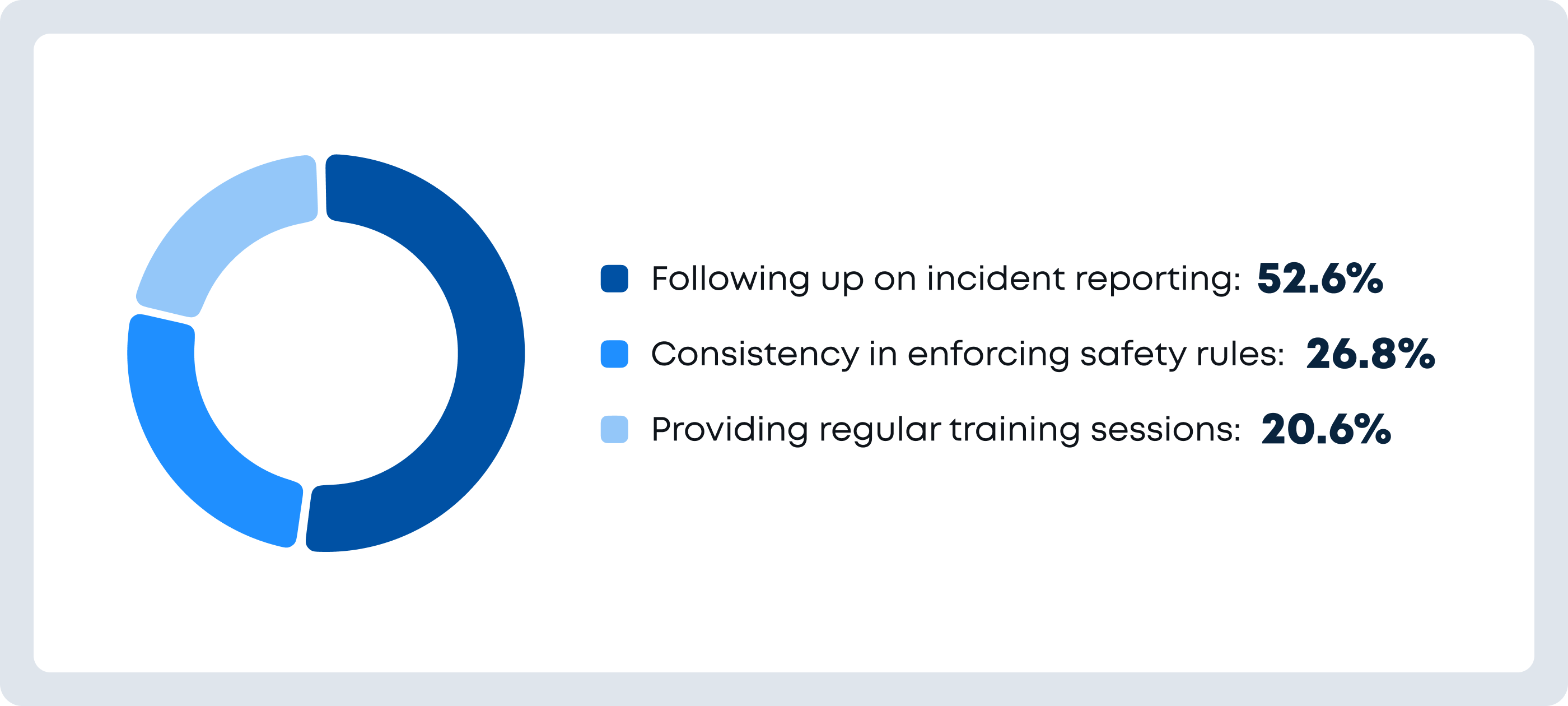What makes a great field leader? We wanted to hear straight from the source, so we asked.
In a recent poll, we surveyed 307 jobsite operators across construction, energy, and aviation to uncover what truly sets exceptional leaders apart. We also spoke with some of our customers to hear their firsthand experiences.
The results? Five key lessons that define great field leadership. Some may confirm what you already believe, while others may surprise you. Let’s dive in.
Contents:
1. They Communicate Clearly
This one’s a no-brainer. Most field professionals believe that communication is the foundation of great leadership.

And just as many blame bad communication when things fall apart
It’s not that we have leaders running around trying to confuse people. We assume we’ve said enough when we haven’t said what’s needed.
George Bernard Shaw nailed it when he said: “The single biggest problem in communication is the illusion that it has taken place.”
How can you make sure your message lands?
- Check for understanding. A foreman shared his simple but foolproof method: “I ask my crew to say it back in their own words. If they can’t, I know we need to go over it again.”
- Make it easy for people to speak up. A solar site supervisor told us, “I need to make sure workers are comfortable coming to me. This means never shutting down concerns, never making someone feel like they’re a bother, and always giving a sincere thanks for bringing it to my attention. ”
- Use the right tools. An aviation ops manager explained, “When there’s a maintenance issue, I need to get the right people on it fast. Calls and texts aren’t that reliable, so I log it all out on digital tools I trust.”
2. They Stay Cool Under Pressure
The job throws punches. Equipment breaks, the weather report gets it wrong, deliveries don’t show up. Too many leaders lose control when those moments come.

That’s a real problem in field industries like construction and energy, where leadership failures can cost projects, reputations, and safety.
Of those who reported seeing their leader get overwhelmed, most reported experiencing at least one of the following:
- Communication breakdowns
- Loss of team focus
- Small issues escalating
- Preventable mistakes
- Missed deadlines
That’s a powerful and damaging chain reaction.
So, how do you show up when things go off the rails?
- Your team takes its cues from you, so find a way to stay calm. Step away for a few minutes, take a few deep breaths, or write things down to clear your head. The steadier you are, the steadier your team will be.
- Get the full picture before making decisions. In the heat of the moment ask yourself “Do I have all the information I need?” If the answer is no, don’t guess, go and get it.
- If a job is on hold, don’t let your team sit around. Give them a task like reviewing past jobs, checking equipment, or reviewing safety protocols. Even five minutes of productive prep keeps momentum going and keeps teams ready for when work picks back up.
3. They Prioritize Safety
Plenty of research links safety to management commitment, and our own survey confirms it. 78% of field professionals say safety comes down to leadership.
But we wanted to go deeper here. So, we followed up by asking: what leadership actions make the biggest impact on jobsite safety?
Here are the top three.

- Workers stop speaking up when hazards get reported and ignored. They figure it’s a waste of their time, and just like that, you lose your best eyes on the ground.
Fix it: Set up a system that guarantees every report gets tracked and closed out. Whether it’s a live dashboard, a ticketing system, or something else, what matters is transparency. If workers can see that hazards aren’t just logged but actually resolved, they’ll keep speaking up.
- Consistency in enforcing safety rules matters because risks feel abstract, but consequences feel real. It’s hard to picture a serious injury from skipping a hard hat today, but getting called out by your boss? That’s easy to imagine. And easy to fear.
Fix it: Pre-emptively define rules for every infraction, and enforce them every time, for everyone. No exceptions, no gray areas. When the rules don’t bend, workers are much less likely to break them
4. They Are Approachable
If your team isn’t talking to you, it’s not because everything’s fine. Turns out, many field professionals keep quiet because they think speaking up won’t make a difference anyway.
The numbers are concerning.

This type of silence creates a domino effect. First, people start feeling less motivated. Then, they’re less likely to step up, take initiative, or engage with the team. The longer this goes on, the more you’ll see turnover, lost opportunities, and, maybe even safety issues.
In field industries that already struggle with staff shortages and high pressure deadlines, this is a huge problem,
To keep your lines of communication open, we suggest:
- Paying attention. If your team thinks you’re half-listening, they’ll stop trying. Put your phone down, make eye contact, and acknowledge what they’re saying. Small cues like nodding and asking questions show you’re actively tuned in.
- Making time for check-ins. Don’t wait for problems to come to you. Set aside at least 20-30 minutes a week for informal, casual conversations with your team. Show you’re available to them consistently.
- Being transparent when you can’t say yes. You won’t always be able to give people what they want but you can be upfront about why. Explaining decisions builds trust. While people don’t need to hear yes every time, they do need to know they were heard.
5. They Make Decisions and Own Them
For many, leadership is synonymous with decision-making. But when trust in you and your calls fade, so does control.
You might start seeing team members hesitate to perform their duties, bypass protocols, and make calls that should’ve gone through you. Sometimes this comes at the expense of efficiency, sometimes at the expense of safety. Either way, when trust in leadership disappears, order does too.
So, what’s killing confidence in leadership?
- Relying on gut feelings instead of facts. If you’re making calls based on instinct alone, don’t be surprised when your team questions them.
Fix it: Stop guessing. Use real data from past projects, track performance trends, and pull in real-time field insights. There’s no excuse to fly blind when so many tools for data collection and analysis are within reach.
- Not communicating the reason behind your decisions. Even the right calls can fall flat when they aren’t explained. 58% of workers admit they’ve delayed work because they weren’t confident in leadership’s choices.
Fix it: Explain your decisions and tie them back to real outcomes. For example, “We’re shifting the schedule because the weather’s turning, and we don’t want to get caught mid-task.” Or “We’re switching suppliers because the last batch had a 15% failure rate, and I’m not risking that again.”
- Dodging responsibility. Some leaders avoid admitting mistakes because they think it’ll make them look weak. They worry they’ll lose respect, embarrass themselves, and make their team doubt their abilities.
But frontline workers see it a different way.

Fix it: If you screw up, own it. Be upfront about what went wrong, what you learned, and what’s changing. Teams don’t expect you to be perfect, but they do expect you to be honest. You’ll also need to apply what you’ve learned to make better decisions moving forward.
Final Thoughts
A title isn’t what defines a leader. Actions do.
The best leaders earn trust through clear communication, strong decisions, and a steady presence when things get tough. They don’t just manage teams: they support them, guide them, and set them up for success.
But they don’t have to do it alone. The right tools make leadership easier.
Fluix helps leaders build better systems to improve communication, increase transparency, and create safer worksites. If that sounds like the kind of support you need, reach out now.




